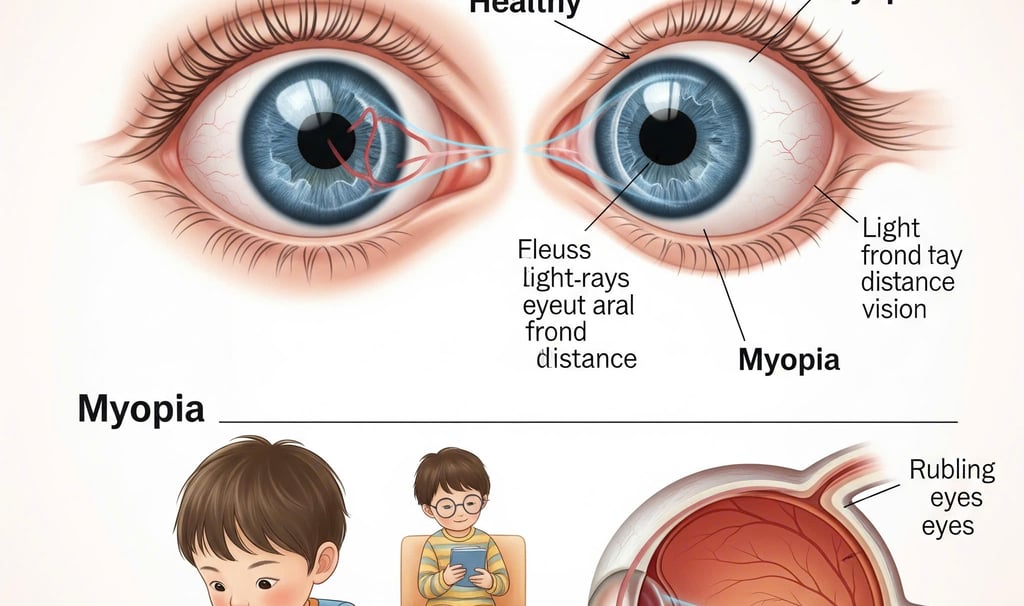Early signs of myopia in children - What is an automatic refractometer?
3/15/20257 min read


Introduction to Myopia in Children
Myopia, commonly known as nearsightedness, is a prevalent refractive error that affects a significant number of children worldwide. This condition occurs when the eye is either too long or the cornea is too curved, causing distant objects to appear blurry while close-up vision remains clear. As technology use and close-up activities, such as reading and screen time, continue to rise, myopia rates among children have notably increased over the past few decades. Recent studies suggest that nearly 30% of children experience some degree of myopia by the time they reach adolescence. Understanding the implications of myopia is crucial, as early detection can greatly influence the management of this condition.
The importance of recognizing the early signs of myopia in children cannot be overstated. Often, myopia develops gradually, and symptoms such as squinting, eye strain, or difficulty in seeing the board at school may be dismissed as normal developmental changes. However, if left untreated, myopia can progress and lead to more serious eye health issues, including an increased risk of glaucoma, retinal detachment, and cataracts. Not only do these long-term consequences pose threats to visual health, but they can also significantly impact a child's academic performance and social interactions.
In light of the growing prevalence of myopia among children, it is essential for parents and educators to be vigilant about eye health. Regular eye examinations become paramount, especially as children transition into environments where visual demands are heightened. Using modern technologies, such as automatic refractometers, can aid in the swift and accurate detection of myopia, ensuring that children receive appropriate corrective measures at the earliest possible stage. This proactive approach not only helps in managing current vision issues but also contributes to a lifetime of better eye health.
Common Early Signs of Myopia
Myopia, commonly referred to as nearsightedness, is a refractive error that affects a child's ability to see distant objects clearly. One of the earliest indicators of this condition is squinting. Children may squint in an effort to focus better on objects that are far away, indicating that their visual acuity is compromised. If a child often squints while watching television or looking at the board in class, it may signal the onset of myopia.
Another prominent sign to monitor is difficulty seeing distant objects. Parents might notice that their child struggles to recognize faces at a distance, or has trouble reading signs while in a moving vehicle. This decline in distance vision can lead to frustration, as children may become reluctant to participate in outdoor activities or sports where distance vision is important.
Additionally, some children may engage in the behavior of covering one eye, typically to enhance their visual clarity. This behavior can indicate an attempt to compensate for blurred vision in one eye, which can be a diagnosis of amblyopia, commonly associated with myopia. Furthermore, frequent eye rubbing, irrespective of environmental factors like dust or allergies, should not be overlooked. Persistent eye rubbing might suggest strain caused by difficulty focusing properly.
It's critical for parents and caregivers to recognize these early signs and seek professional eye care. Early identification and intervention can prevent the progression of myopia and safeguard a child's overall visual development. Regular eye examinations can help detect refractive errors at an early stage, ensuring that appropriate corrective measures, such as glasses or contact lenses, can be implemented promptly. By staying vigilant about these symptoms, parents are better equipped to support their child's visual health.
Consequences of Untreated Myopia
Untreated myopia, commonly known as nearsightedness, poses significant risks that extend beyond just poor vision. One of the most concerning consequences is the progressive worsening of eyesight. As a child’s eyes continue to develop, uncorrected refractive errors can exacerbate myopia, leading to a more severe form. This progression can limit the child’s ability to engage in everyday activities, potentially hindering their social interactions and causing frustration in academic settings. The inability to see distant objects clearly can create challenges in a traditional classroom setting, where visual clarity is essential for learning.
The impact of untreated myopia on a child's learning and development cannot be overstated. Vision plays a critical role in cognitive and physical development; if children struggle to see the board or read printed materials, they may fall behind in school. This can lead to decreased self-esteem and increased anxiety, further complicating their educational journey. Moreover, children with uncorrected myopia may become less active, as their inability to see clearly can dissuade them from engaging in outdoor play or sports, which are vital for their physical development and socialization.
In addition to immediate educational impacts, untreated myopia can lead to severe future complications. Research indicates that individuals with high levels of myopia are at an increased risk of developing serious eye conditions, such as retinal detachment and glaucoma. These conditions can significantly impair vision and may ultimately lead to irreversible blindness. Therefore, it is crucial to recognize and address the early signs of myopia to mitigate these potential outcomes. By doing so, parents and guardians can ensure that children receive appropriate interventions, allowing them to thrive both in school and throughout life.
What is an Automatic Refractometer?
An automatic refractometer is a sophisticated instrument used in the field of optometry to assess refractive errors in the eyes, including conditions such as myopia, hyperopia, and astigmatism. The device utilizes advanced optical technology to measure the way light is bent as it passes through the eye, enabling a precise determination of the appropriate lens prescription required for optimal vision correction.
The functioning of an automatic refractometer is based on a principle known as photorefraction. When light is directed into the eye, it reflects off the retina. This reflected light is then analyzed by the device to assess the eye's refractive power. The results allow optometrists to quickly and accurately identify whether a patient, particularly children, has myopia or any other refractive error. Unlike traditional methods, which often involve subjective input from patients regarding their vision, automatic refractometers provide objective data, ensuring a higher level of accuracy and reliability.
One of the significant advantages of using an automatic refractometer is its speed and efficiency. The device can complete a full assessment in a matter of minutes, greatly reducing the time spent during eye examinations. This speed is particularly beneficial in pediatric settings, where children may become restless or anxious. Additionally, the automation of this process lessens the burden on eye care professionals, allowing them to focus their expertise on treatment and patient education rather than on the intricacies of manual refraction techniques.
Moreover, the high level of precision offered by automatic refractometers minimizes the chance of human error, resulting in accurate prescriptions that can enhance visual outcomes for children suffering from myopia. Overall, this innovative instrument represents a significant advancement in the ability to diagnose and manage refractive errors effectively, reflecting the ongoing evolution of optometric technology.
How Automatic Refractometers Help in Detecting Myopia
Automatic refractometers play a critical role in the early detection of myopia in children by providing precise and reliable measurements of refractive errors. These advanced devices utilize automated technology to assess an individual's vision systematically, making the process both efficient and accurate. One of the primary advantages of an automatic refractometer is its ability to deliver quick results, allowing practitioners to conduct examinations in a fraction of the time typically required by traditional methods. This speed not only enhances the overall patient experience but also facilitates timely interventions that are crucial for managing early signs of myopia.
The accuracy of measurements obtained from automatic refractometers is paramount in diagnosing myopia. These devices minimize human error and variability, often achieving higher precision levels than manual assessments. Given that the onset of myopia can lead to adverse long-term effects on a child’s vision, obtaining accurate refractive measurements is essential. Medical practitioners rely on the information gathered from these refractometers to make informed decisions regarding diagnostics and subsequent treatment options. Moreover, the devices can assist in tracking the progression of myopia over time, thus providing a comprehensive understanding of a child's visual development.
Another significant benefit of using automatic refractometers in the context of preventive eye care is their ability to identify subtle refractive changes before they become more pronounced. Regular screenings using these devices help in determining the need for corrective lenses or additional interventions early on. By ensuring that children receive the appropriate vision care at an early stage, the potential risks associated with untreated myopia can be substantially reduced. Overall, the implementation of automatic refractometers in pediatric ophthalmology represents a proactive approach in safeguarding children's visual health.
Recommendations for Parents: Monitoring and Screening
As children grow, it becomes increasingly important for parents to actively monitor their vision, especially with the rising incidence of myopia. Early detection is crucial in mitigating the impacts of this condition, which can lead to more serious ocular issues. To facilitate this, parents should prioritize regular eye examinations for their children. The American Optometric Association recommends that children receive their first comprehensive eye exam at six months of age, followed by additional screenings at three years, and before starting school. Thereafter, annual check-ups are typically advised, although the frequency may increase if any visual problems are detected.
During these eye exams, eye care professionals will typically conduct various tests to assess vision clarity and eye health. Parents can expect assessments that include visual acuity tests, which measure how well a child sees at various distances, along with screenings for eye coordination and focusing ability. Automatic refractometers may also be employed, providing objective measurements of refractive errors, which can help in determining the necessity for correctional lenses more swiftly. Understanding these processes can help alleviate any anxiety children might associate with eye appointments.
Furthermore, parents should maintain open communication with their eye care providers. If any signs of myopia, such as squinting, difficulty seeing distant objects, or excessive eye rubbing, are observed, discussing these symptoms with an ophthalmologist or optometrist is essential. These practitioners can provide tailored advice based on a child’s unique circumstances, contributing to effective management strategies to limit the progression of myopia. Proactive care is vital in ensuring that your child's visual health receives the attention it deserves, ultimately supporting their overall well-being and development.
Conclusion
In summary, the early signs of myopia in children are critical indicators of future visual health and should not be overlooked. Children are often unable to articulate their vision problems, making it essential for parents and caregivers to be vigilant about any changes in their children's behavior, such as increased squinting, difficulty reading distant objects, or excessive eye rubbing. Recognizing these early signs can lead to timely interventions that may help slow the progression of myopia, ensuring better visual outcomes in the long run.
Utilizing automatic refractometers plays a pivotal role in modern eye care by providing accurate and efficient measurements of refractive errors. These devices enable eye care professionals to diagnose myopia at an early stage, allowing for the implementation of corrective measures tailored to each child’s needs. Regular vision screenings with automatic refractometers not only help in early detection but also offer a baseline for monitoring changes in eye health over time. This proactive approach is particularly important as the prevalence of myopia continues to rise globally.
To prioritize their children's eye health, parents are encouraged to schedule regular vision assessments, especially if there is a family history of myopia. By advocating for consistent monitoring and seeking help from healthcare providers, parents can create a supportive environment that promotes optimal visual development. Ultimately, early intervention is key in managing myopia and ensuring that children can enjoy a lifetime of good vision. Maintaining awareness of eye health and actively engaging in preventive care can significantly enhance children's overall quality of life and academic performance.
